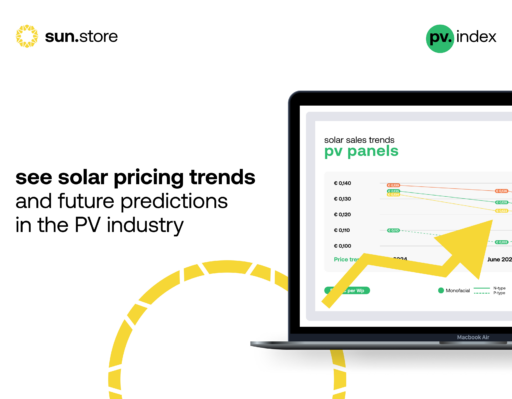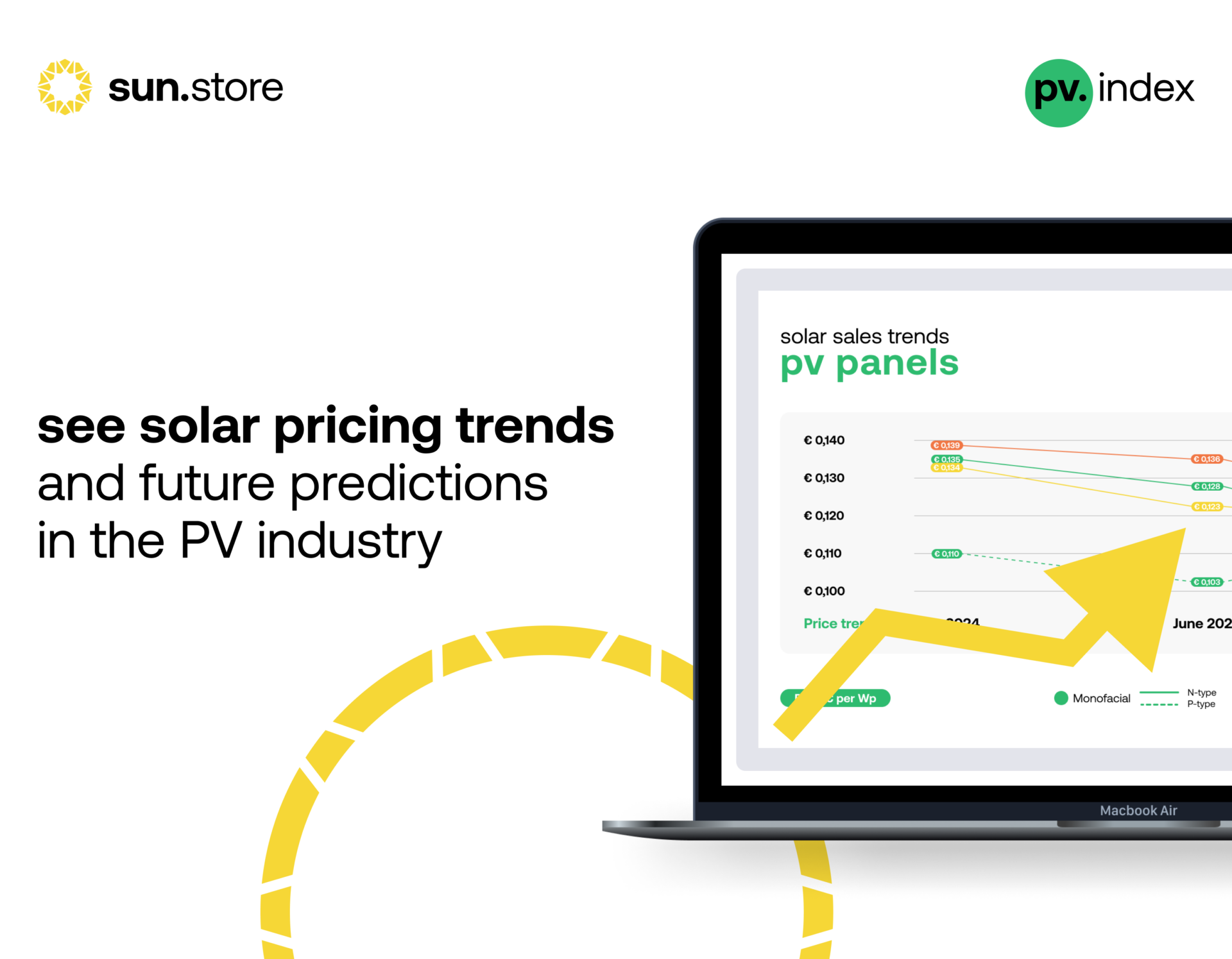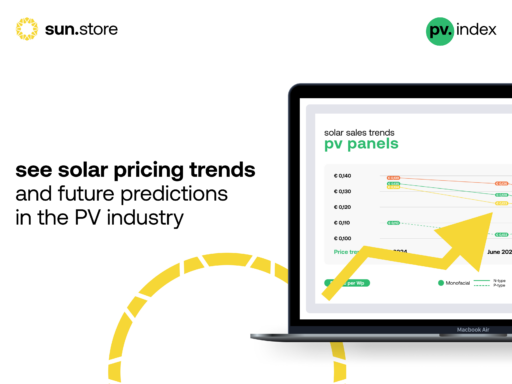General price decline continues amid steady demand in the European solar market
The European PV market in October 2024 saw a mixture of stability and seasonally driven changes. Overall, we saw a continued downward trend in solar component prices across most categories, highlighting a market adjusting to seasonal shifts and inventory dynamics. The PV Purchasing Managers’ Index (PMI) edged down to 68, returning to its August level, signaling that demand remains resilient, but the season is drawing to a close. October’s pv.index report also unveils two key expansions: detailed insights into inverter categories and a fresh design to make the data even more accessible.
Expanding pv.index: new categories, new insights
Agata Krawiec-Rokita, CEO of sun.store, commented on the report’s expansion: The pv.index has been a cornerstone in helping our users make informed purchasing decisions, and we’re excited to introduce a more detailed breakdown in the inverter market. By separating hybrid and on-grid inverters, with further distinctions between power ranges, we’re providing a deeper layer of insight. This addition, combined with our new, clearer layout, enhances the usability of the report for a growing audience.
Market sentiment and buyer behavior
The PV PMI (Purchasing Managers’ Index), which gathers purchasing intentions from buyers across the sun.store platform, continues to offer a critical insight into the pulse of the European PV market. sun.store, as Europe’s largest solar marketplace, remains at the forefront of these market trends, now with over 18,000 registered users and more than 7 GW of solar components available from a wide range of suppliers. The index serves as a key indicator of future demand, capturing the confidence and buying patterns of industry participants.
PV PMI reflects cautious optimism
In October, the PV Purchasing Managers’ Index (PMI) slightly declined, settling back to 68, which matches the level from August. This decrease comes after a brief uptick in September, indicating a cautious approach as the industry moves towards year-end. Buyers are adjusting their purchasing plans with the season’s end in sight, yet confidence remains relatively stable, with 50% of respondents planning to increase their orders, 37% intending to maintain current levels, and only 13% anticipating a reduction. This steady demand outlook suggests that, despite price fluctuations, optimism persists across Europe’s solar market.
This confidence reflects resilience in the European PV market, even as the sector contends with seasonal and economic factors. As noted by Krzysztof Rejek, Head of Business Development at sun.store, The stable PMI at 68 shows that the demand for solar components remains strong, yet slighltly decreasing versus previous months. Seasonal factors, coupled with a reduction in installation activities as winter approaches, have influenced purchasing behavior. However, the industry is still vibrant, and we’re seeing a steady demand for high-quality components.
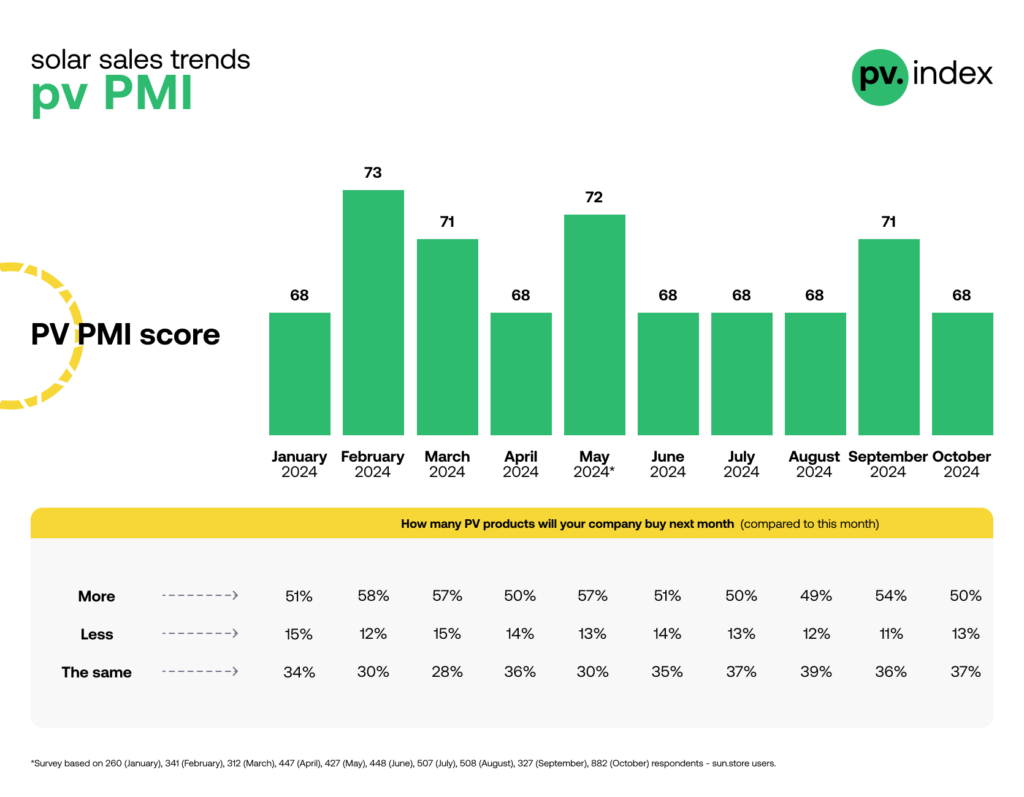
Key findings for October 2024: panel and inverter pricing
Panel prices show mixed trends
October continued the downward price trend across most PV panel categories. Notably:
Monoracial modules:
N-type: prices fell by 15%, landing at €0.098/Wp, down from last month’s €0.105/Wp, as oversupply persists.
P-type: prices for P-type modules showed a modest decrease of 1%, now at €0.090/Wp, compared to €0.091/Wp in September, suggesting relative price stability in this segment.
Bifacial modules:
N-type: modules saw a notable 10% drop, reaching €0.103/Wp, down from €0.114/Wp in September, indicative of competitive pressures and market saturation
P-type: sample size was too limited to determine a conclusive trend this month.
Full black modules:
Full black modules experienced a price decline of 9%, moving to €0.099/Wp, compared to €0.109/Wp last month, reflecting a steady oversupply and competition among suppliers.
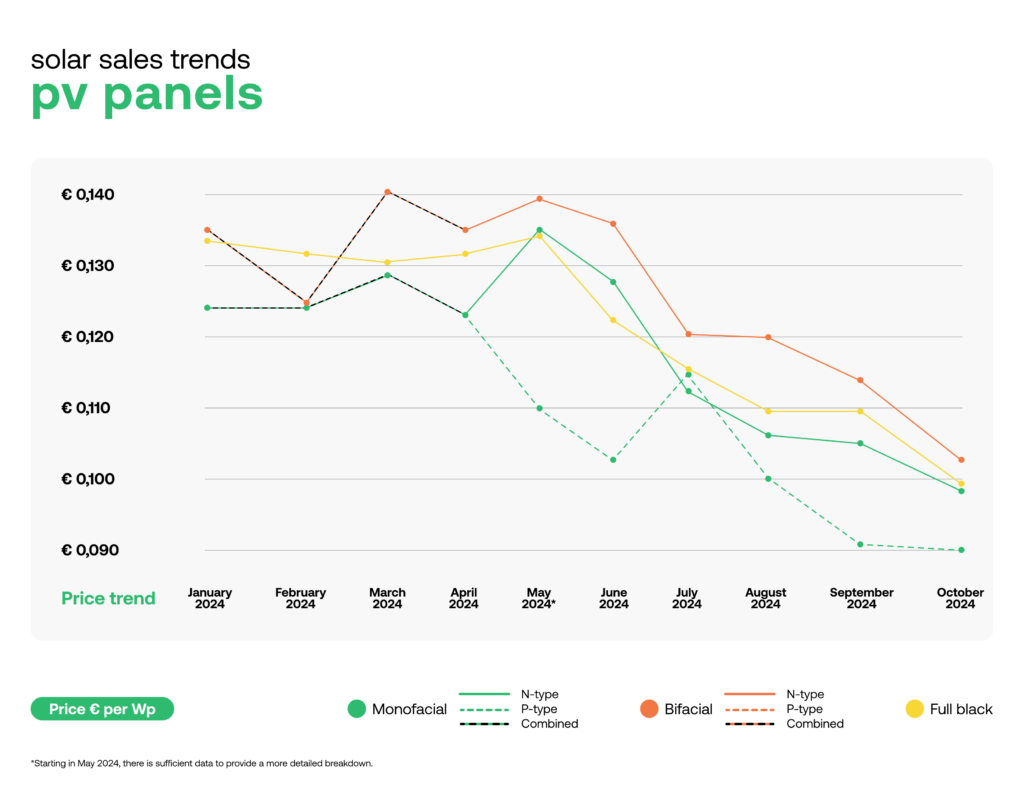

Inverter prices reveal nuanced shifts
For the first time, we are including inverters in the PV Index. Over the past three months, we have observed a steady decrease in prices for these components.
Hybrid Inverters:
<15kW: Prices have decreased by 7% over the last three months, from €128/kW to €119.25/kW. This reduction aligns with slightly lower-than-expected demand for residential installations, coupled with constant oversupply, prompting suppliers to adjust prices for smaller capacity units.
15+ kW: Larger hybrid inverters experienced a 5% price drop between August and September, stabilizing in autumn (September to October) with a slight 1% increase to €90.69/kW, up from €90.18/kW last month. This increase reflects a shift towards premium brands, such as Huawei, indicating a preference for high-quality products in larger-scale projects.
On-grid Inverters:
<15kW: A 13% drop in string inverters for residential use shows both a shift to hybrid options and downward pricing trends in the residential segment. The average price for smaller on-grid inverters fell by 2%, reaching €67.85/kW from €69.21/kW in September, suggesting a price recalibration as the market stabilizes following the summer peak.
15+ kW: Inverters over 15 kW in the on-grid category experienced a 2% rise, with prices increasing to €27.11/kW from €26.49/kW. As with hybrid inverters, this increase is largely driven by a preference for higher-performance brands, reinforcing the trend toward premium choices in larger installations.
Krzysztof Rejek, Head of Business Development at sun.store, comments on the current pricing dynamics:
The trend of module stock devaluation continues with sellers trying to increase their sales figures. We expect for that situation to remain actual especially due to upcoming Black Friday promotions and year-end clearances
This trend allows buyers to secure top-quality components much below regular costs, fueling demand and opening up new opportunities for projects across Europe. We anticipate these attractive prices will continue, providing a unique chance for our users to capitalize on some of the best deals of the year.
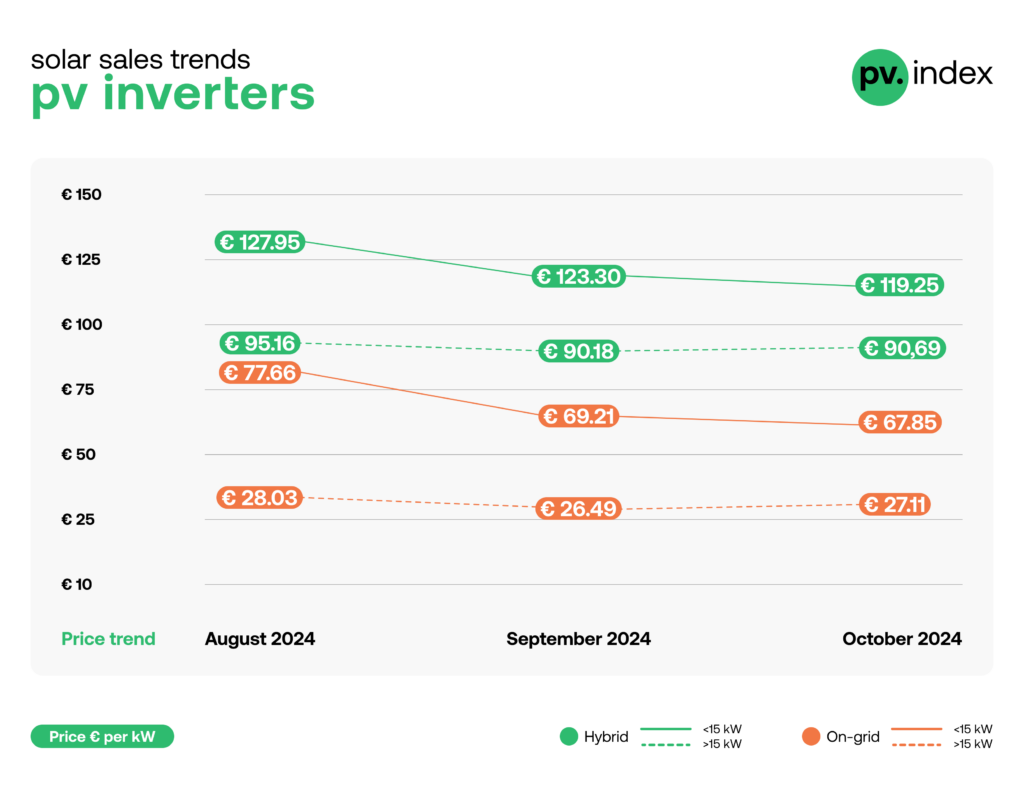
October’s most preferred brands
In terms of brand preference, Jinko Solar dominated across all panel categories (Monofacial, Bifacial, and Full Black), continuing its streak as a top choice among sun.store users. For inverters, Solis emerged as the preferred brand for systems under 15kW, while Sungrow led in the 15+ kW category, demonstrating a strong demand for reliable, high-performance equipment in larger installations.
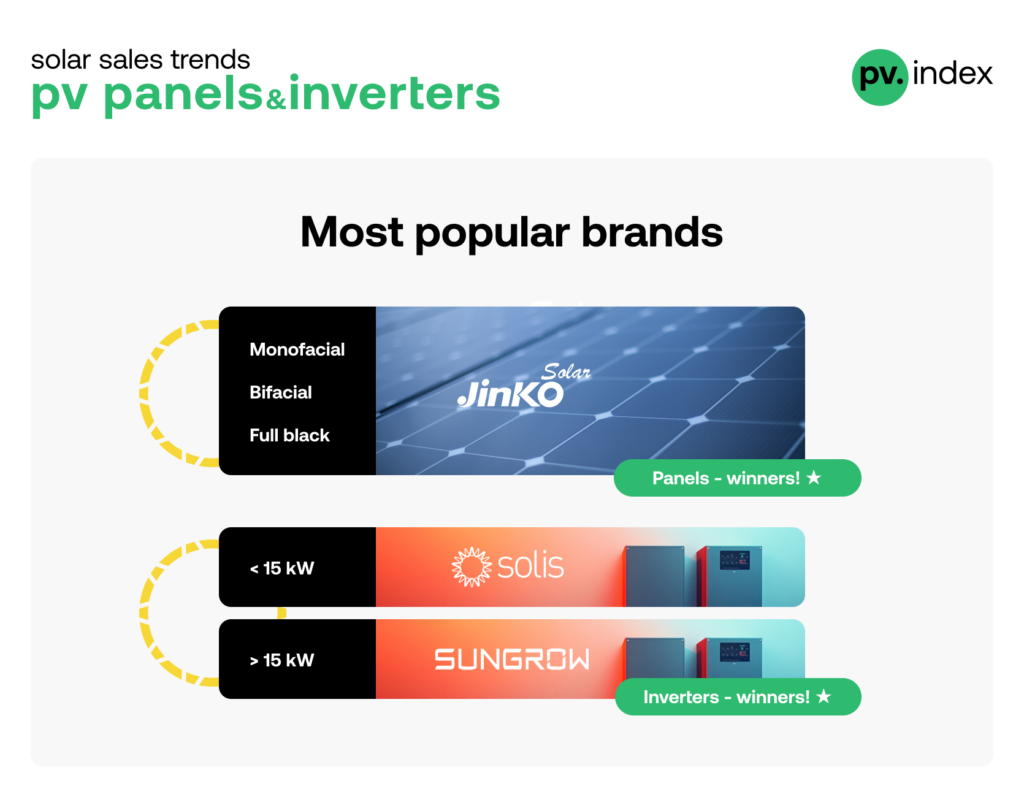
In summary
As we wrap up October, the latest pv.index provides a clear view of current market dynamics in the European solar industry. Despite ongoing price drops across various panel types and the addition of a nuanced inverter analysis, demand remains steady, with buyers showing confidence and adapting to seasonal shifts. With a new, improved design and an expanded scope, sun.store’s pv.index continues to be a critical resource for the industry, guiding buyers and sellers alike through a changing landscape.
About – pv.index & The PV Purchasing Managers’ Index (PV PMI)
pv.index traces current trading prices for solar components on a monthly basis. Data is recorded on sun.store, the biggest online PV trading platform with 7.8 GW+ of components on offer. Trading prices are weighted by the power of components involved in the transactions to arrive at a reliable estimate for the whole market.
The PV Purchasing Managers’ Index (PV PMI) is a measure indicating the overall sentiment towards the demand in the PV industry. PV PMI shows whether demand is expected to expand (above 50), remain stable, or contract (below 50), as perceived by purchasing managers.
The PV PMI was calculated as: PMI = (P1 * 1) + (P2 * 0.5) + (P3 * 0), where: P1 = percentage of answers reporting an improvement, P2 = percentage of answers reporting no change, P3 = percentage of answers reporting a deterioration. Survey is based on a sample of 800+ sun.store buyers.
What is sun.store
sun.store is the biggest online trading platform for solar components. Its more than 18,000 registered users from 40+ countries have constant access to 7.8 GW+ of available components from 200+ manufacturing brands, located in more than 1000 warehouses across Europe. This diversity ensures that the installers have constant access to the best deals on a wide range of equipment, from various manufacturers of modules, inverters, storage solutions, and all necessary accessories.
sun.store is currently available in 7 languages and provides its users with logistics services as well as safe payment options – all to make sure that PV component trading online becomes as smooth an experience as possible.
 EN
EN ES
ES DE
DE PL
PL IT
IT FR
FR GR
GR